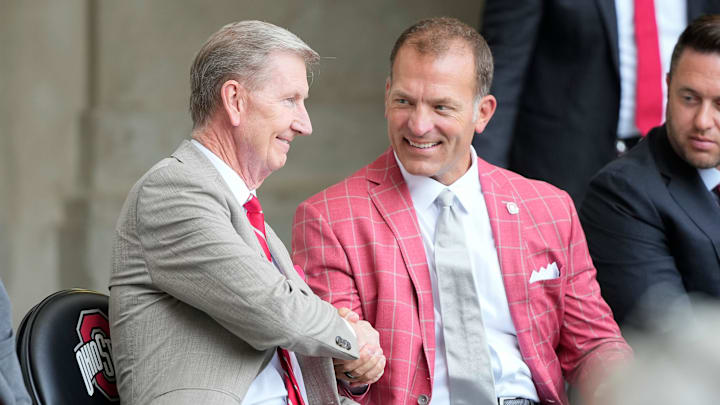The landscape of college football is shifting faster than TreVeyon Henderson on a screen pass through the Texas defense!
Recent developments like the House settlement, the proposed SCORE Act, and the push for collective bargaining are reshaping the sport, and the Buckeyes are ready to capitalize. With Athletic Director Ross Bjork both steering the ship for Ohio State and deeply involved with the recent changes to College Football, Ohio State’s strategic moves and massive fan base make it a powerhouse in this new era of revenue sharing and regulated Name, Image, and Likeness (NIL) deals.
The House settlement, a multi-billion-dollar agreement finalized in 2025, is a game-changer. It allows schools to share revenue directly with athletes, capped at $20 million annually, while cracking down on shady NIL deals orchestrated by booster-backed collectives.
The College Sports Commission (CSC), the settlement’s enforcement arm, is already rejecting deals that don’t meet a “valid business purpose,” particularly those from collectives trying to skirt the cap with pay-for-play schemes disguised as NIL.
Ohio State, under Bjork’s leadership, has been well out in front and prepared for this new reality. By bringing NIL operations in-house and partnering with firms like Learfield, the Buckeyes are playing by the rules and avoiding the pitfalls of third-party collectives.
Some programs have seemingly given in to temptation to try and game the system, as they have thrived in the wild west era of college athletics, where money has been flaunted and seemingly purchased players. Ohio State’s compliance-focused approach ensures it won’t face the CSC’s wrath of penalties that could range from fines to roster restrictions, depending on the violation’s severity.
The introduction of the SCORE Act in Congress is just one more piece of reassurance that Ohio State and Ross Bjork have been prepared. This bipartisan bill, moving at lightning speed, aims to codify the settlement’s rules into federal law, preempting state laws like those in Tennessee or Michigan that tried to dodge oversight. It also protects athletes from predatory agents by capping fees at 5%.
While other programs like those up north have banked on legal loopholes, Ohio State’s legal team—backed by the university’s formidable resources—knew Congress was likely to step in. The SCORE Act’s swift progress means the Buckeyes’ above-board approach will pay dividends, potentially limiting recruiting disruptions to just one cycle.
Ohio State’s edge doesn’t stop at compliance. The Buckeyes’ massive fan base and deep-pocketed alumni network are tailor-made for the new NIL landscape. With millions of supporters and Ohio State's national brand, businesses across America are lining up to ink legitimate NIL deals with Buckeye players.
Jeremiah Smith's recent deal with Adidas is a prime example. Ohio State is giving players real deals that pass the CSC’s scrutiny, not collectives funneling booster cash. Ohio State’s in-house Buckeye Sports Group can broker these deals, acting as a middleman to connect players with companies while staying within the rules. This setup maximizes opportunities for athletes to earn without risking penalties, and bolsters their names before they ever get to the NFL.
As the sport inches toward a model where athletes are treated more like employees, the Buckeyes’ infrastructure—legal expertise, financial resources, and brand power—positions them to negotiate favorable terms. Unlike smaller programs or those reliant on single billionaires, Ohio State’s broad support base and institutional stability make it a leader in shaping this future.
The Juck on Bucks podcast nailed it: the days of collectives are numbered, and Ohio State’s decision to internalize operations was a masterstroke. While collectives scramble to justify their existence, Ohio State is building a sustainable model that empowers athletes and engages fans without the chaos of “lawlessness.”
In this new era, Ohio State isn’t just keeping up—they’re setting the pace. The House settlement ensures fair compensation, the SCORE Act locks in a level playing field, and collective bargaining looms as a chance to cement their advantage.
With Bjork’s foresight, a compliance-first mindset, the national brand of Ohio State, and a fan base that bleeds scarlet and gray, the Buckeyes are poised to dominate recruiting, revenue, and, yes, the national championship race. As the CSC shuts down shady deals and Congress steps in, Ohio State’s rivals might be sweating, but Buckeye Nation can sit back and enjoy the view from the top.
